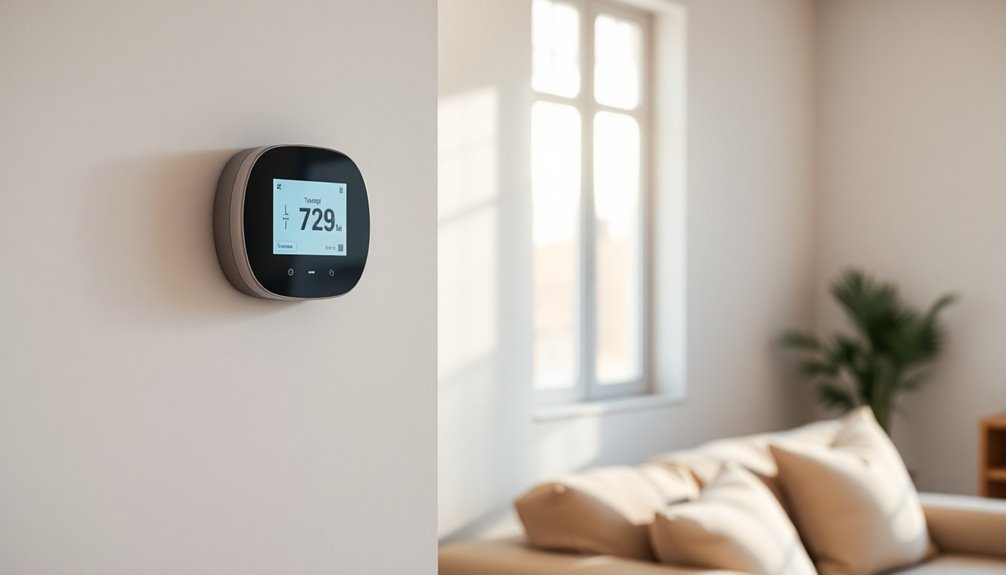Switching to a line voltage thermostat can greatly cut your energy costs while optimizing your heating system's performance. These thermostats operate at 120V or 240V and allow for direct control of electric heating systems, like baseboard heaters. Opting for a double pole thermostat enhances energy efficiency by completely disconnecting power when not needed. This not only maintains your desired comfort levels but also reduces your monthly bills. Plus, smart thermostats can offer even greater savings with their programmable features. Keep going to discover all the options that can help maximize your energy savings.
Understanding Line Voltage
When you think about line voltage, it's vital to understand that it typically operates at 120V or 240V, which is common in residential heating systems. This voltage level is essential for line voltage wiring found in electric heating applications, like baseboard heaters.
Unlike low voltage systems, which need transformers, line voltage can be connected directly to your heating units, simplifying installation and maintenance. Clear payment terms are essential for managing the costs associated with these systems effectively. Utilizing tools like expense tracking tools can further enhance your financial efficiency in managing energy costs.
Using line voltage wiring allows for efficient energy management. The line voltage thermostat directly controls the power delivery to your heating system based on the room temperature.
These thermostats can manage higher power loads, making them ideal for electric resistance and convection heating systems. When the temperature dips below the set point, the thermostat switches the power on, and when it reaches the desired level, it turns off, ensuring maximum energy use.
To identify line voltage systems, check for high voltage labels, use a voltage meter for readings over 120V, and observe the wire thickness in the gang box. Additionally, utilizing automated bill payment notifications can help maintain financial control over your energy costs by ensuring timely payments for heating bills, which enhances your overall financial stability(#).
Understanding these basics of line voltage will help you make informed decisions about heating and energy efficiency in your home.
What Is a Line Voltage Thermostat?
A line voltage thermostat directly controls high voltage systems, usually at 120V or 240V, to regulate electric heating like baseboard heaters.
You'll find different types, such as single pole and double pole, each serving specific needs in energy efficiency and functionality. Timely payments are essential for keeping the costs of energy-efficient systems manageable. Utilizing tools like YNAB (You Need A Budget) can help freelancers manage their finances and allocate funds for energy-efficient upgrades.
When installing one, it's essential to take into account the voltage requirements and guarantee proper maintenance for peak performance. Additionally, using modern solutions like expense management apps can help monitor and reduce energy costs effectively.
Definition and Functionality
You might be surprised to learn that a line voltage thermostat plays an essential role in controlling electric heating systems. It directly manages the operation of your heaters by delivering 120V or 240V power, based on the room temperature.
Here's how it works:
- Temperature Measurement: It measures the ambient temperature in your space.
- On/Off Control: It turns the heating elements on or off to maintain your desired temperature setpoint.
- Wiring Simplicity: Typically used with electric heating systems like baseboard heaters, line voltage thermostats provide a straightforward solution without the need for transformers.
- Pole Configuration: They come in single pole or double pole models, with double pole versions allowing complete power shutoff for better energy management.
Look for high voltage warnings or specific voltage ratings on the thermostat to verify it's suitable for line voltage applications.
This distinction helps you differentiate it from low voltage thermostats. By understanding the definition and functionality of line voltage thermostats, you can make informed decisions about your home heating systems and save on energy costs.
Types of Thermostats
Line voltage thermostats are specifically designed to control electric heating systems by managing higher power levels, typically 120V or 240V. Unlike low voltage thermostats, which require transformers and deal with lower power levels, line voltage models provide a direct connection to your heating system.
You'll find two main types of line voltage thermostats: single pole and double pole.
Single pole thermostats are simpler to install but offer limited energy management capabilities. They work well for straightforward heating control but mightn't provide the efficiency you're looking for.
On the other hand, double pole thermostats allow for complete disconnection from power, offering better energy efficiency and control.
These thermostats are commonly used with electric baseboard heaters and other resistance heating systems, ensuring precise temperature control by turning heaters on or off based on the room temperature.
To identify a line voltage thermostat, check for high voltage labeling (120V/240V), count the number of thermostats in your home, or use a voltage meter for verification.
Installation Considerations
When installing a line voltage thermostat, it's essential to understand its unique power requirements and functionality. These thermostats operate on 120V or 240V and connect directly to electric heating systems like baseboard heaters.
To guarantee a successful installation, keep the following considerations in mind:
- Power Load: Line voltage thermostats handle higher power loads than low voltage models, making them ideal for electric resistance and convection heaters.
- Thermostat Wires: Look for thicker wires associated with line voltage systems; they're necessary for supporting the electrical demands.
- Type Selection: Choose between single pole or double pole types. Double pole models allow for complete disconnection of power, offering better energy management.
- Code Compliance: Always verify you follow local electrical codes and secure wire connections to prevent hazards.
Single Pole vs. Double Pole Thermostats
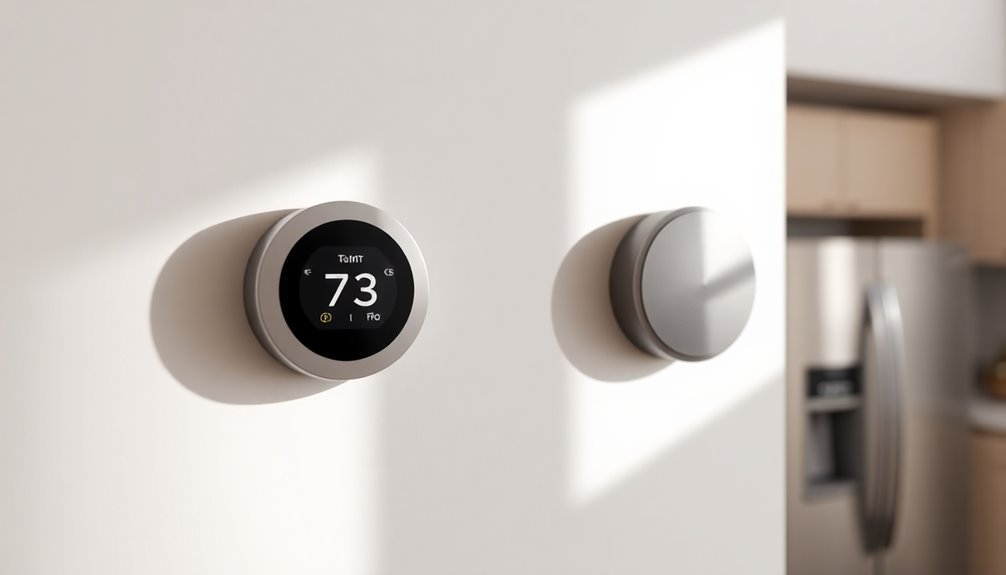
When you're deciding between single pole and double pole thermostats, consider how installation simplicity and energy management efficiency play a role in your choice.
Single pole models are easier to install but can lack energy efficiency due to their inability to fully disconnect power. Budget apps can help you track expenses related to energy usage, allowing you to identify areas for potential savings. Additionally, utilizing goal tracking features in budgeting apps can aid in monitoring your energy expenses over time. In contrast, double pole thermostats provide better energy management but often require a more complex installation process. Additionally, implementing budgeting apps can help you monitor and reduce energy costs effectively.
Installation Simplicity
Simplicity in installation can greatly impact your choice between single pole and double pole thermostats. If you're looking for ease, single pole thermostats are a popular option. They require only two wires, making them straightforward to set up. However, they lack an off setting, which can lead to reduced efficiency.
On the other hand, double pole thermostats, while more complex, offer significant advantages. Here are four key points to take into account regarding installation simplicity:
- Wiring Complexity: Single pole requires two wires; double pole needs at least four.
- Power Disconnection: Double pole allows for complete power disconnection, enhancing safety.
- Energy Efficiency: Double pole thermostats avoid power stealing, guaranteeing efficiency even when off.
- Professional Help: It's wise to consult a qualified electrician for double pole installations to guarantee safety and compliance.
While single pole thermostats suit basic heating needs, double pole options are recommended for better energy savings and safety in line voltage applications.
Energy Management Efficiency
Choosing between single pole and double pole thermostats can markedly influence your energy management efficiency.
Single pole thermostats are easier to install, requiring only two wires and one switch. However, they lack an off setting, which can lead to power stealing and reduce their overall energy efficiency. This means that even when you think your heating system is off, it might still be drawing power.
On the other hand, double pole thermostats need at least four wires. This allows for a complete disconnection from power, enhancing your energy management by eliminating power stealing altogether. With a true off setting, double pole models guarantee no energy is wasted when the heating system isn't needed.
While single pole thermostats may seem convenient, double pole thermostats generally provide better control and efficiency in electric heating systems.
Ultimately, your choice can greatly impact your energy costs. Consequently, it's wise to consult a qualified electrician when installing or switching between these types to assure compliance with safety standards and peak performance.
Investing in a double pole thermostat can lead to considerable long-term savings on energy bills.
Identifying Line Voltage Thermostats
Identifying line voltage thermostats is essential for guaranteeing the proper operation of electric heating systems.
You'll want to recognize a few key features to confirm you're dealing with a line voltage thermostat. Here's a handy checklist:
- Voltage Rating: Look for high voltage labeling or warnings indicating it operates at 120V or 240V.
- Wire Thickness: Check for thicker wires in the gang box; these are typical for line voltage systems.
- Number of Thermostats: Count the thermostats in your home; multiple thermostats usually suggest line voltage systems, particularly in homes with electric heating.
- Voltage Meter: Use a voltage meter. If it shows high voltage levels, you've got a line voltage thermostat on your hands.
Additionally, if you don't see a gang box around the thermostat, that's another indicator you might be looking at a line voltage type. Understanding expense categorization can also help homeowners budget for energy costs effectively. Regular monitoring of your savings and investments can also contribute to more informed energy management decisions. Utilizing personal finance tools can enhance your ability to track energy-saving investments and optimize costs.
Low voltage systems typically require extra components and enclosures.
Safety Precautions for Installation
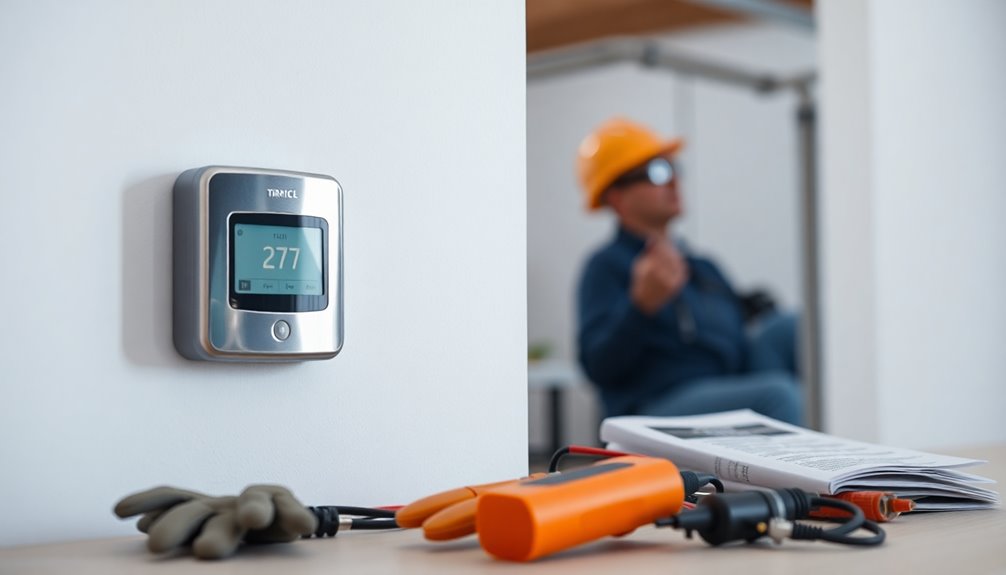
When installing a line voltage thermostat, it's essential to prioritize safety by using the right tools and isolating the circuit.
Always check your local codes to confirm compliance, as this can prevent hazards down the line. Additionally, consider using a budgeting app like YNAB to ensure you have funds set aside for any necessary tools or professional help during installation. Investment tracking tools can also assist in planning for future expenses related to home improvements.
Taking these precautions not only keeps you safe but also assures a proper installation. Additionally, understanding the importance of financial health can help you budget for any necessary tools or professional help during installation.
Proper Tools Usage
Before diving into the installation of a line voltage thermostat, it's important to prioritize safety by using the right tools. Proper tools usage not only guarantees a smoother installation process but also safeguards you against potential hazards.
Here are four key tools you should have on hand:
- Insulated Tools: Always use insulated tools designed for electrical work. These tools help prevent accidental shorts and reduce the risk of injuries.
- Voltage Meter: A voltage meter is essential for verifying that no electrical current is present in the wires before you start making connections. This step is critical for your safety.
- Personal Protective Equipment (PPE): Wear gloves and safety goggles while handling electrical components. This PPE enhances safety and protects you from potential injuries.
- Local Electrical Codes: Familiarize yourself with local electrical codes and regulations. This knowledge guarantees that your installation is compliant and safe.
Circuit Isolation Importance
Assuring circuit isolation is an essential step in the installation of a line voltage thermostat. This process helps prevent electrical hazards by making sure no power flows through the wires while you're making connections.
To start, always turn off the circuit breaker supplying power to the thermostat. This action eliminates the risk of electric shock, allowing you to work safely.
Before you disconnect any wires, take a moment to properly label them. This simple step can help you avoid confusion during reinstallation and assure that your wiring connections are correct.
Once labeled, use a voltage meter to confirm that no voltage is present in the wires. This extra precaution adds an additional layer of safety before you handle any electrical components.
Local Code Compliance
Local electrical codes play an essential role in the safe installation of line voltage thermostats. Confirming local code compliance isn't just about following the rules; it's crucial for your safety and the efficiency of your system.
Here are some key safety precautions to take into account:
- Consult Local Codes: Always check your local electrical codes and regulations before starting any installation. This confirms compliance and safety.
- Power Verification: Use a voltage meter to confirm that the power supply is off before you begin. This helps prevent electrical shocks.
- Secure Connections: Pay close attention to wire connections. Misidentified ground wires can create hazardous situations, so follow color coding standards carefully.
- Hire Professionals: For complex installations, think about hiring a qualified electrician. They can guarantee adherence to safety protocols and local code compliance.
Regular inspections and maintenance of your line voltage thermostats are also necessary to confirm they operate safely and efficiently.
Compatibility With Existing Systems
When you switch to a line voltage thermostat, it's important to confirm that your existing heating system can handle the higher voltage, typically 120V or 240V. This voltage is compatible with electric heating systems like baseboard and convection heaters, eliminating the need for transformers.
However, verify the existing wiring can manage the power load; low voltage systems might require complex rewiring for compatibility with higher voltage levels.
You'll also need to take into account the type of thermostat. Single pole thermostats are easier to install but may not provide a true off setting, while double pole thermostats allow for a complete power disconnection, enhancing compatibility with various electric heating setups.
If you're opting for smart line voltage thermostats from brands like Mysa or Sinope, double-check their compatibility with your current electric heating system, focusing on wattage and wiring.
Additionally, if your home relies on electric resistance zonal heat, you may qualify for rebates when installing these new thermostats. This not only promotes energy efficiency but also guarantees that your upgrade maintains compatibility with your existing heating infrastructure.
Benefits of Smart Line Voltage Thermostats

Upgrading to a smart line voltage thermostat offers numerous advantages that can considerably enhance your home's energy efficiency. By making the switch, you can enjoy significant savings and convenience.
Here are four key benefits:
- Cost Savings: Smart thermostats can save you up to 26% on electric bills by optimizing temperature management and minimizing energy waste.
- Remote Access: With smartphone app control, you can adjust your thermostat settings from anywhere, ensuring your home is always at the ideal temperature.
- Programmable Features: The ability to set schedules and utilize geofencing technology means your thermostat automatically adjusts based on your occupancy patterns, further enhancing comfort and savings.
- Energy Monitoring: Many smart line voltage thermostats provide detailed energy usage analysis, helping you track consumption and make informed adjustments to reduce costs even more.
Switching to smart thermostats not only improves your home's efficiency but also adds a layer of convenience to your daily life.
Embrace the technology and enjoy a more comfortable, cost-effective living environment.
Features of Smart Thermostats
Smart thermostats come packed with features designed to elevate your home's energy management and comfort. One standout feature is geofencing, which detects your location and adjusts the temperature accordingly. This can save you up to $100 annually by optimizing settings and reducing energy waste.
Additionally, many smart thermostats boast learning capabilities that adapt to your preferences, allowing them to create personalized schedules for efficient temperature management.
Remote access via smartphones and tablets enhances your control over heating systems, so you can adjust settings from anywhere, further contributing to energy savings. You'll also appreciate real-time feedback on energy usage; this insight helps you make informed decisions about your heating habits, ultimately reducing costs.
Another impressive feature of smart thermostats is weather responsiveness. These devices can automatically adjust heating based on current weather conditions, ensuring your home remains comfortable while minimizing energy consumption.
With all these features of smart thermostats, you'll not only enhance your home's comfort but also make strides toward a more energy-efficient lifestyle. Embracing these technologies can lead to substantial savings while keeping your home cozy.
Wiring Practices and Considerations
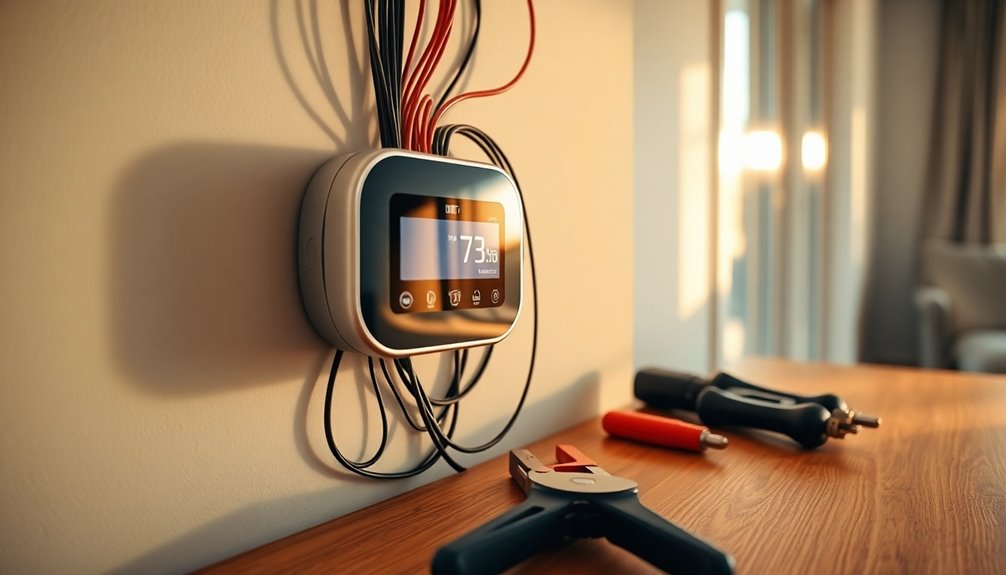
When installing a line voltage thermostat, choosing the right wire gauge is essential for safety and efficiency.
You should also pay attention to color coding, as it helps prevent mistakes during the installation process.
Finally, secure connections will protect you from electrical hazards and guarantee your thermostat operates correctly.
Proper Wire Gauge Selection
Selecting the right wire gauge is essential for guaranteeing the safety and efficiency of your line voltage thermostat installation. Using the correct gauge helps prevent overheating and guarantees reliable operation.
Here are some key points to evaluate when choosing your wire gauge:
- Use 14 gauge wire for safely handling 120 VAC and 240 VAC currents in most installations.
- 18 gauge wire can be used for thermostat connections, but make sure it connects properly to the 14 gauge wire to maintain safety and functionality.
- Check existing wires if you're repurposing them for new thermostats; verify the wire gauge matches the power requirements for efficient operation.
- Isolate thermostat wires from AC circuits during installation to prevent electrical hazards and guarantee a reliable connection.
Color Coding Importance
Understanding the importance of color coding in thermostat wiring is essential for ensuring safe and efficient installations. Proper color coding helps you prevent confusion during connections and reduces the risk of electrical hazards.
In standard practices, the green wire typically designates ground connections, while black or red wires are used for power. White wires usually indicate neutral. Misidentifying these colors can lead to dangerous situations, such as electrical shocks or circuit failures, underlining the need to adhere to established wiring standards.
When you're extending connections, remember that using the right gauge wire is vital. For line voltage systems, a 14 gauge wire is often recommended to handle the current safely.
Regularly verifying wire functions and maintaining a clear understanding of color coding not only enhances safety but also boosts reliability in thermostat installations and repairs.
Safe Connection Practices
Proper connection practices are key to guaranteeing safe and effective thermostat installations. When dealing with line voltage thermostats, it's vital to follow specific guidelines to prevent hazards and guarantee longevity.
Here are some essential safe connection practices you should keep in mind:
- Use New 18-4 Wire: Always run new 18-gauge wire, as it can safely handle 24 VAC current.
- Secure Connections: Confirm all connections are tight to avoid electrical hazards, and use color coding to simplify the process.
- Isolate Wires: During installation, isolate thermostat wires from AC circuits to maintain safety and functionality.
- Check Compatibility: If repurposing existing line voltage wires, pay close attention when connecting 18-gauge wire to 14-gauge wire for compatibility.
Additionally, always consult local electrical laws and regulations before diving into any electrical work. This guarantees you adhere to safety standards, protecting both yourself and your home.
Troubleshooting Common Issues
When troubleshooting common issues with line voltage thermostats, it's often the small details that make a big difference. Start by inspecting the wiring connections. Loose or damaged wires can lead to flaky performance, so check for reliability and replace any worn or frayed wires.
Regular maintenance is vital to avoid future problems.
If your thermostat isn't operating correctly, grab a voltage meter. This tool will help you verify if electricity is flowing properly, allowing you to determine whether the issue lies within the thermostat or the heating system itself.
Also, be aware of the age of your thermostat; older models may not function efficiently and could need an upgrade to a smart thermostat for better performance.
Finally, pay close attention to wire functions. Misidentified ground wires or improper connections can lead to electrical shocks, so confirm everything's correctly installed before making any changes.
Maintenance for Longevity
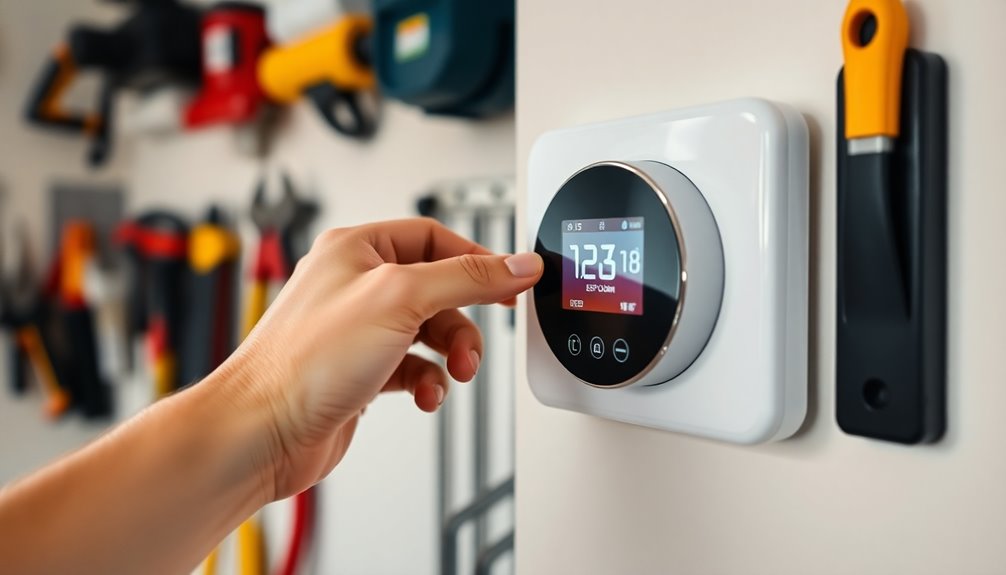
After troubleshooting any issues with your line voltage thermostat, maintaining it becomes essential for guaranteeing its longevity. Regular maintenance helps prevent flaky performance and secures reliable operation. Here are some key steps to follow:
- Check and Tighten Connections: Inspect the wire connections regularly. Loose wires can lead to performance issues, so make sure they're secure.
- Inspect and Clean Annually: Cleaning the thermostat at least once a year helps maintain peak performance and extends its lifespan.
- Replace Aging Wires: Promptly replace any aging or damaged wires. Old wiring can cause electrical hazards and inefficient heating.
- Utilize Systematic Troubleshooting: Adopt a systematic approach when troubleshooting. Verifying connections and testing voltage levels can help catch issues early, reducing costly repairs.
Additionally, consider upgrading to smart line voltage thermostats. These models often feature energy usage analysis, enhancing your monitoring and maintenance efficiency.
Community Support and Knowledge Sharing
Community support plays an essential role in guiding the complexities of line voltage thermostat installation and maintenance. By participating in community forums and online platforms, you can connect with HVAC professionals and DIY enthusiasts who share valuable troubleshooting tips and wiring practices. This collaborative knowledge sharing enhances your understanding of common installation challenges, allowing you to navigate issues effectively.
Local HVAC workshops often emphasize community support, giving you the chance to learn directly from experienced technicians. Hands-on experience in these settings can demystify the installation process, making it more approachable.
You'll also find that clear communication is crucial in technical discussions, helping promote safe and efficient practices when dealing with line voltage wiring.
As community members exchange wiring color codes and standards, you can reduce the risk of misidentifying wire functions during thermostat changes. This shared knowledge not only fosters safer installations but also builds a network of support that you can rely on.
Engaging with your community strengthens your skills and confidence, ensuring that you tackle line voltage thermostat tasks with a greater sense of assurance.
Energy Savings From Smart Thermostats
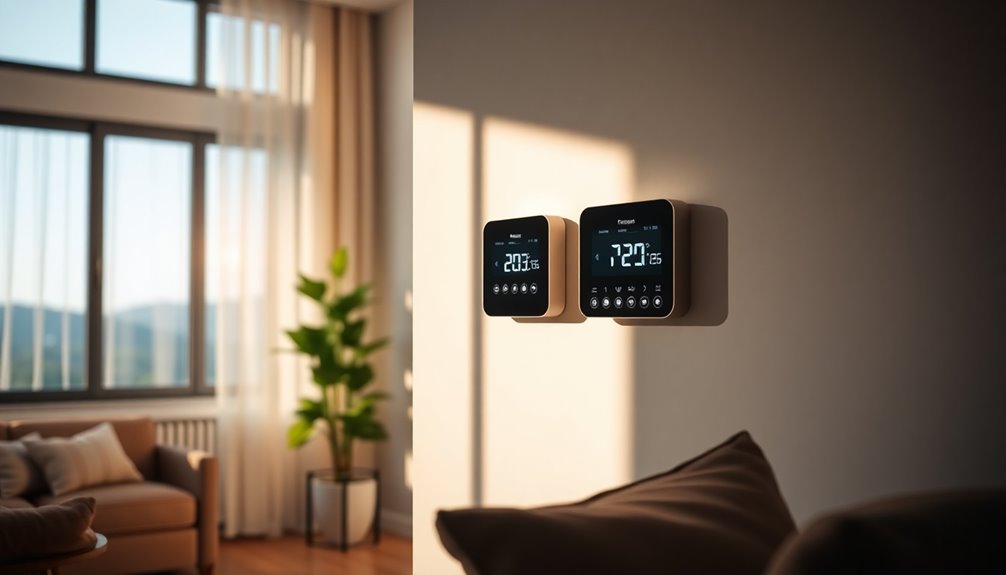
Installing a line voltage thermostat can be a great step toward energy efficiency, especially when you consider upgrading to a smart thermostat.
These devices not only optimize temperature settings but also help you save money.
Here are four ways smart thermostats promote energy savings:
- Automatic Adjustments: They adjust temperatures based on your behavior and preferences, reducing energy waste by 10-30%.
- Geofencing Features: Smart thermostats use geofencing to detect when you're home or away, ensuring you're not heating or cooling an empty house.
- Real-Time Feedback: Many models provide insights into your energy usage, empowering you to make informed decisions about your heating and cooling habits.
- Lower Costs: On average, homeowners save up to $100 annually by using smart thermostats, benefitting both your wallet and the environment.
Available Rebates for Thermostats
If you're considering upgrading to a new thermostat, you might be pleased to know that there are available rebates that can help offset the costs.
For those installing standard line-voltage thermostats (LVT), you can receive a rebate of $40. If you opt for a qualifying line-voltage communicating thermostat (LVCT), the rebate increases to $75.
To take advantage of these available rebates, your home must primarily use electric resistance zonal heating, and you'll need to replace your existing thermostat with an eligible model.
Make sure your new line-voltage thermostat features a digital display and complies with UL or CSA listings, as these are essential for rebate eligibility.
You've got time to act, too; applications for these rebates will be accepted until March 31, 2025.
Once you submit your application, rebate checks are generally issued within 6-8 weeks after approval, following verification of correct installation and eligibility.
This means you can enjoy your new thermostat and the associated energy savings, all while getting some money back.
Don't miss out on these available rebates—start your upgrade today!
Conclusion
To sum up, switching to a line voltage thermostat can revolutionize your energy savings like a supernova illuminating the night sky. By understanding the differences between single and double pole models, prioritizing safety during installation, and embracing smart technology, you're not just conserving energy—you're taking control of your costs. With available rebates, your wallet will thank you as you bask in the glow of your newfound efficiency. Start your journey toward savings today!

